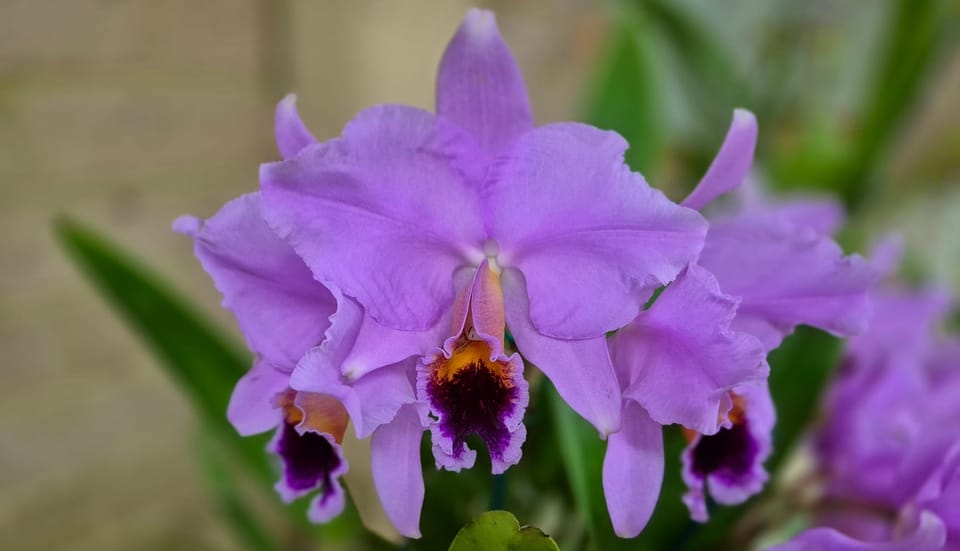7 Stunning Rare Orchid Species: My favourites (2025 Guide)

As an orchid collector, I've spent years cultivating a huge variety of species, and I'm thrilled to share my experience with these seven favourite species. Each one brings something unique to the table, from spectacular blooms to fascinating growth patterns.
Understanding the Allure of Vanda javerii
Vanda javerii stands as one of the most captivating orchids in any serious collection. What makes this species particularly special is its extraordinary white flowers . Native to the Philippines, this epiphytic orchid produces blooms that can reach up to 3 inches across, with a distinctive pattern that seems to shimmer in proper lighting.
Growing Vanda javerii successfully requires understanding its natural habitat. In cultivation, it thrives in bright, indirect light with humidity levels between 60-80%. The key to success lies in providing consistent moisture without waterlogging the roots. Most successful growers mount this species or grow it in a basket rather than potting it, allowing for the excellent air circulation that mimics its natural growing conditions.
One fascinating aspect of V. javerii is its growth pattern – it's a monopodial orchid, meaning it grows upward from a single point, producing aerial roots along its stem. These roots play a crucial role not just in nutrient uptake but also in maintaining the plant's stability. Regular misting of these aerial roots is essential for optimal growth.
I was lucky enough to grab one of these early on in my orchid growing adventure and then during a timeof transition regretably sold it. I'm glad to say I've since sourced another plant or two which I am gleefully awaiting to flower later this year.
The Sunshine Charm of Renanthera citrina
Renanthera citrina, sometimes called the Yellow Renanthera, brings a burst of sunshine to any orchid collection. This Vietnamese species produces sprays of vibrant yellow flowers that seem to glow from within. Unlike many other Renanthera species that trend toward reds and oranges, R. citrina's lemon-yellow blooms make it a standout specimen.
The most remarkable aspect of this orchid's cultivation is its adaptability. While it certainly prefers warm conditions, it can tolerate a wider temperature range than many of its relatives and surprising to many grows well in my shadehouse in Sydney without much special care in winter. The plant grows best when mounted or in well-draining baskets, allowing its long roots to grow freely.
Success with R. citrina often comes down to understanding its growth cycles. The species typically blooms in October and November for me here in Sydney and I've found that despite them being quite delicate in texture the flowers are relatively long lasting even after a heat wave or two common that time of year.
Sophronitis cernua: The Miniature Marvel
Don't let its small size fool you – Sophronitis cernua packs an incredible punch in terms of flower power. This Brazilian miniature produces blooms that are disproportionately large for its compact size, with vibrant orange-red flowers that can nearly overwhelm the tiny plant. Each bloom measures up to 2 inches across on a plant that might only be 3-4 inches tall.
What makes S. cernua particularly interesting is its preference for cooler conditions than many tropical orchids. Native to higher elevations in Brazil, it appreciates temperatures that drop into the single figures (°C) at night, making it an excellent choice for growers who can't maintain consistently warm conditions.
The species has earned its reputation as a "beginner-friendly" miniature, thanks to its forgiving nature and regular blooming habit. It is certainly my preferred suggestion over Soph. coccinea for example which has a reputation for being picky and difficult. That said while individual flowers are much smaller in Soph. cernua a well grown specimen is still most definitely capable of covering itself in bloom.
However, success depends on understanding its preference for high humidity combined with excellent air movement. I definately prefer to mount over potting as the plant is not a fan of moist mix at all.
The Distinguished Paphiopedilum haynaldianum
Paphiopedilum haynaldianum represents the epitome of slipper orchid elegance. This Philippine species produces sophisticated, multi-flowered inflorescences that can carry up to five flowers at once – a remarkable trait among slipper orchids. Each bloom features intricate patterns of green, brown, and purple, with distinctive twisted petals that can reach several inches in length.
Unlike many orchids that prefer mounting, P. haynaldianum is strictly terrestrial in nature. It requires a well-draining but moisture-retentive medium that mimics the forest floor debris of its natural habitat. The secret to success lies in maintaining consistent moisture while avoiding waterlogged conditions that can quickly lead to root rot.
Perhaps the most fascinating aspect of this species is its blooming behavior. Flowers can last up to two months, the intricate markings on each flower are thought to mimic insects, playing a crucial role in its natural pollination strategy.
Perhaps one of the best parts for me
Discovering Holcoglossum kimbalianum
Holcoglossum kimbalianum emerges as one of the most intriguing members of its genus. This compact vandaceous orchid, native to Vietnam, produces crystalline white flowers with subtle pink tinges that seem to float in air. Its charm lies not just in its flowers but in its unique growth habit – the plant grows upright with terete leaves that take on a wave type patern as the plant matures.
What sets H. kimbalianum apart is its remarkable adaptation to life in the air. In nature, it grows with minimal root contact on bare branches, surviving primarily on moisture from morning dew and rainfall. This adaptation makes it particularly suitable for mounted culture in cultivation, though achieving the right balance of moisture can be challenging.
The key though to success with these plants is light and loads of it, I have had several plants that grew excellently with few flowers and it wasn't till I moved them into almost full sun that they finally started to produce spikes.
The species shows remarkable resilience to temperature fluctuations, tolerating both warm days and cool nights. This adaptability, combined with its compact size, makes it an excellent choice for growers with limited space but good light conditions.
This species has always captivated me, it has several forms including an alba and a dark lip form and while I haven't yet flowered the latter, the anticipation is killling me.
The Cultural Significance of Cymbidium ensifolium
Cymbidium ensifolium holds a special place in Asian horticultural history, having been cultivated for over 2,000 years. This species, known as 建兰 (Jiànlán) in Chinese culture, represents one of the four noble plants in Chinese tradition, alongside plum blossom, bamboo, and chrysanthemum.
What makes Cym. ensifolium particularly remarkable is its delicate fragrance – a sweet, penetrating scent that has inspired poets and artists for generations. The flowers, though smaller than modern Cymbidium hybrids, possess an elegant simplicity with their cream to yellow-green coloring, often enhanced by subtle red markings.
The species demonstrates exceptional adaptability in cultivation, tolerating both cool and intermediate conditions and grows well in Sydney unlike some others in this group like Cym. goeringii that many growers struggle with. Unlike many other Cymbidiums, it remains compact, making it suitable for smaller growing spaces. Its growth pattern follows distinct seasonal rhythms, with new growths emerging in spring and blooming typically occurring in late summer to fall.
What has always captivated me about this species is its variety and delicate nature, I now have several plants in various stages of growth from seedling to mature and the variety of growth, leaf shape and colour as well as flower shape and colour is amazing.
Cattleya percevilliana: A Collector's Pride
Cattleya percevilliana stands as a testament to the natural beauty of the genus. This Brazilian species produces large, showy flowers that combine rich lavender sepals and petals with a darker purple lip, often enhanced by golden yellow veining in the throat. What sets it apart from other Cattleyas is its blooming season – it's one of the few species that reliably flowers during winter months.
The cultural requirements of C. percevilliana reflect its mountain habitat origins. It appreciates bright light but cooler temperatures than many of its relatives, particularly during the night. This temperature differential plays a crucial role in initiating flower bud development. It also gives it a rare attribute being a large flowered 'Exhibition' Cattleya that can tolerate lower temps of warm temperate and subtropical areas
Most fascinating for me about this species is its variable nature – even within the same population, flowers can show significant differences in color intensity and patterning. This natural variation has made it particularly valuable in breeding programs, contributing to the development of numerous award-winning hybrids.
These seven orchid species represent some of the most fascinating examples of orchid evolution and diversity. Whether you're drawn to the commanding presence of Vanda javerii or the delicate charm of Sophronitis cernua, each species offers unique rewards for the dedicated grower. Remember, successful cultivation comes down to understanding and replicating their natural conditions.
That said, this is my list for 2025 and who's to say this will stay the same for 2026. Which of these magnificent orchids will you add to your collection first?

Member discussion